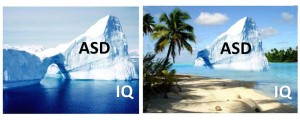ASD in 3D – Part III (“The warmer the water, the faster the ice melts”)
March 15th, 2013 by drcoplan In the first part of this thread we discussed the symptoms of ASD, and the “natural history” of improvement over time – first noted by Leo Kanner in 1943. In the second part of this thread, we introduced the idea that IQ is independent from atypicality. Every individual with ASD has a unique combination of degree of atypicality, and level of intelligence. We can depict this relationship using an XY graph, with severity of atypicality on the horizontal (X) axis, and IQ on the vertical (Y) axis.
.
IQ is the single biggest factor influencing long-term outcome in children with ASD. This has been known since the 1970’s. Think of atypicality like a hunk of ice, floating in the water. The severity of the atypicality is equivalent to the size of the hunk of ice: it can be a huge iceberg, or a tiny little piece. Think about IQ as being equivalent to the water temperature: freezing cold = low IQ; warm, tropical water = high IQ. Now ask yourself: If we start with two identical hunks of ice, and drop one into the Arctic Ocean and the other into the Caribbean, which will melt faster? The answer is obvious.

.
Read the rest of this entry »












